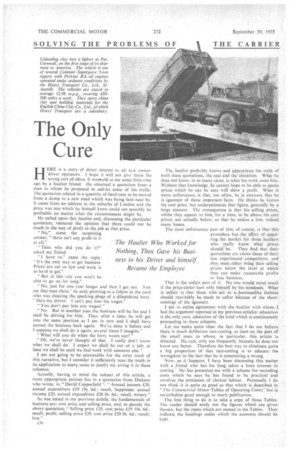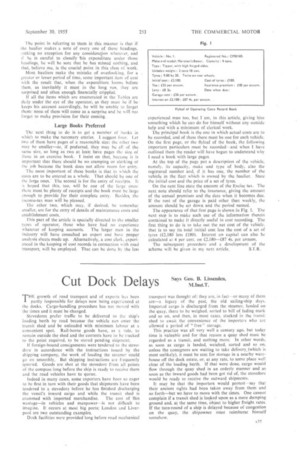The Only Cure
Page 62

Page 63

If you've noticed an error in this article please click here to report it so we can fix it.
}, ERE is a story of direct interest to all new owner driver operators. I hope it will not give them the wrong sort of ideas. It wasItold to me some little time ago by a haulier friend. He obtained a quotation from a man to whom he proposed to sub-let. some of his traffic. The quotation related to a quantity of hard core to be moved from x dump to a new road which was being laid near by. It came from an address in the suburbs of London and the price was one which he hiniself knew could not possibly be profitable no matter what the circumstances might be, He called upon this haulier and, discussing the particular quotation, ventured the opinion that there could not be much in the way of profit in the job at that price.
"No," came the surprising answer, "there isn't any profit in it at all."
"Then why did you do asked my friend.
"I have to," came the reply. "It's the only way to get business. Prices are cut so low and work is so hard to get."
"But at this rate you won't be able to go on for long."
"No, just for one year longer and then I get out. You see that man there." he said, pointing to a fellow in the yard who was cleaning the sparking plugs of a dilapidated lorry. " He's my driver. I can't pay him his wages."
" You don't pay him any wages!"
" No. But in another year the business will be his and I shall be driving for him. Then, after a time, he will get into the same position as I am in now and I shall have earned the business back again. We've done it before and I suppose we shall do it again, several times I imagine."
"What will you do when the lorry wears out?"
"Oh, we've never thought of that. I really don't know what we shall do. I expect we shall be out of a job; at least we shall be until we find work with someone else."
I am not going to be answerable for the strict truth of this narrative, but I consider it sufficiently near the truth in its application to many cases to justify my airing it in these columns.
Actually, having in mind the subject of this article, a more appropriate pointer lies in a quotation from Dickens who wrote, in "David Copperfield": "Annual income £20, annual expenditure £19 19s. 6d.; result, happiness; annual income £20, annual expenditure £20 Os. 6d.; result, misery."
As was stated in my previous article, the fundamentals of business arc: cost price and selling price, and, to parody the above quotation, "Selling price £20, cost price £19 19s. 6d.; result, profit; selling price £20, cost price £20 Os. 6d.; result, loss."
it?"
The haulier probably knows and appreciates the truth of both these quotations, the real and the imitation. What he does not know, in so many cases, is what his work costs him. Without that knowledge, he cannot hope to be able to quote prices which he can be sure will show a profit. What is more unfortunate is that, too often, he is unaware that he is ignorant of those important facts. He thinks he knows his cost price, but underestimates that figure, generally by a large amount. The consequence is that his selling prices,: whilst they appear to him, for a time, to be above his cost prices, are actually below, so that he makes a loss, indeed many losses.
The most unfortunate part of this, of course, is that this procedure has the effect of upsetting the market for those hauliers who really know what prices should be. They find that their quotations are above those of their less experienced competitors, and they must either bring their selling prices below the level at which they can make reasonable profits or lose business.
That is the unfair part of it. No one would mind much if the price-cutter hurt only himself by his misdeeds. What is unfair is that those who act in a businesslike fashion should inevitably be made to suffer because of the shortcomings of the ignorant.
I am in entire agreement with the haulier with whom I had the argument reported in my previous articles: education is the only cure, education of the kind which is continuously proceeding in these columns.
Let me make quite clear the fact that I do not believe there is much deliberate rate-cutting, at least on the part of the small man, to whom, in particular, this article is directed. He cuts, only too frequently, because he does not know any better. Therefore the best way to eliminate quite a big proportion of that rate-cutting is to educate tha wrongdoer to the fact that he is committing a wrong.
Now, as it happens, I have been discussing this matter with a _friend who has for long taken a keen interest in costing. He has presented me with a scheme for recording costs which he says he has found to be practical and involves the minimum of clerical labour. Personally I do not think it is quite as good as that which is described in "The Commercial Motor Tables of Operating Costs." but is nevertheless good enough to merit publication.
The first thing to do is to take a copy of those Tables. The reader should study not the figures which are given therein, but the items which are named in the Tables. They indicate the headings under which the accounts should be kept. The point hi referring to them in this manner is that if the haulier makes a note of every one of those headings, making no exception for any consideration whatever, and if he is careful to classify ittis expenditure under those headings, he will be sure that he has missed nothing, and that, believe me, is the crucial point in this class of work.
Most hauliers make the mistake of overlooking, for a greater or lesser period of time, some important item of cost with the result that, when the expenditure looms before them, as inevitably it must in the long run, they are surprised and often enough financially crippled.
If all the items which are enumerated in the Tables are daily under the eye of the operator, as they must be if he keeps his account aceordingly, he will be unable to forget them: none of them will come as a surprise and he will not forget to make provision for their coming.
Large Books Preferred The next thing to do is to get a number of books in ■ Ahich to make the necessary entries. I suggest four. Let. two of them have pages of a reasonable size; the other two may be smaller—or, if preferred, they may be all of the. same size, so long as two at least have pages the size of those in an exercise book. I insist on that, because it is important that there should be no cramping or shirking of the job because the book does not allow room for entry,
The most important of these books is that in which the costs are to be entered as a whole. That should be one of the large ones. The second is for the entry of receipts. It is hoped that this, too, will be one of the large ones: there must be plenty of receipts and the book must be large enough to provide for their complete entry. Besides, the income-tax man will he pleased.
The other two, which may, if desired, he somewhat smaller, are for the entry of details of maintenance costs and establishment costs.
This part of the article is specially directed to the srnaller types of operator, those who have had no experience whatever of keeping accounts. The larger men in the industry will have consulted an expert and have proper analysis sheets made up. Alternatively, a cost clerk, experienced in the keeping of cost records in connection with road transport, will be employed. That can be done by the less experienced man too, but I am, in this article, giving him something which he can do for himself without any outside help and with a minimum of clerical work.
The principal book is the one in which actual costs are to be recorded, and of these there must be one for each vehicle. On the first page, or the flyleaf of the book, the following important particulars must be recorded—and when I have outlined them the reader will have begun to understand why I need a book with large pages.
At the top of the page put a description of the vehicle, namely, its capacity, make and type of body, also the registered number and, if it has one, the number of the vehicle in the fleet which is owned by the haulier. State the initial cost and the price of a set of tyres.
On the next line state the amount of the Excise tax. The next note should refer to the insurance, giving the amount of the annual premium and the date when it becomes due. If the rent of the garage is paid other than weekly, the amount should be set down and the period named.
The appearance of that first page is shown in Fig. I. The next step is to make such use of the information therein contained to make it directly useful in cost recording. The first thing to do is to take out the net cost of the vehicle. that is to say its total initial cost less the cost of a set of tyres (12,180 less £180). Interest on capital can also be calculated at 4 per cent. on £2,180—f 87 4s. per annum.
The subsequent procedure and a development of the scheme will be given in my next article. S.T.R.




























































































